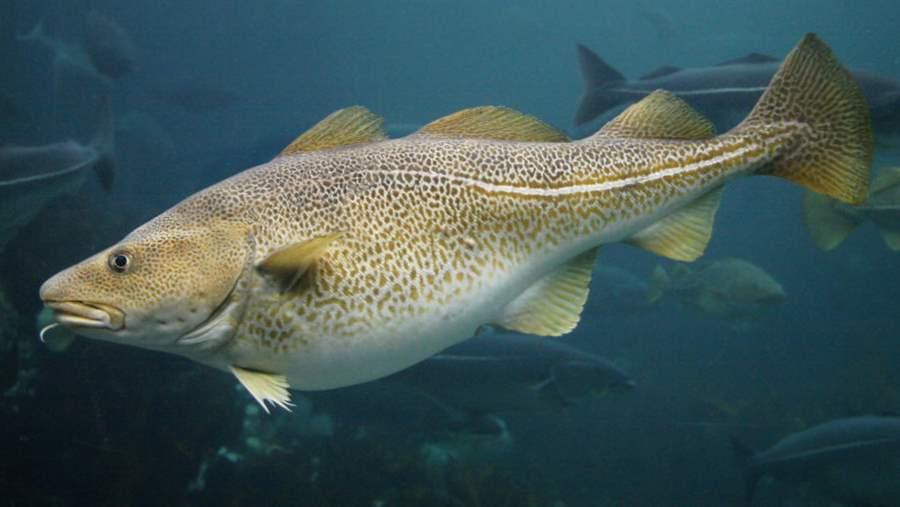Turning the Corner in New England's Historic Fishery
Change by the Numbers
On May 1, 2010, the New England fishery for cod, haddock and other so-called groundfish transitioned to a new management system in which fishermen voluntarily form cooperatives, called sectors. Each sector receives a portion of the annual catch limit based on the historic landings of its members. This replaced a failed management system that, for the past 15 years, attempted to control fishing by limiting the number of days fishermen could spend at sea and the quantity of fish they could bring to port each day.
 © Dieter Craasmann
© Dieter Craasmann
Atlantic Cod Swimming
The first year of fishing under the new sector system ended April 30, 2011, and early reports show that sectors have been successful in several ways.
Catch limits were not exceeded.
The entire groundfish fleet fished well within the annual catch limits, and no sector exceeded any of its allotments.1 Fishing within the science-based limits will bring an end to overfishing and promote rebuilding of depleted stocks. Under the previous management system, known as days-at-sea, the fishery was plagued by overfishing.2
Overall revenue is up.
The price that fishermen are paid for their catch has risen, as has overall revenue for the fishery. In the first year of sector management, revenue was up 10 percent over the previous year.3 Under days-at-sea management between 1994 and 1997, groundfish revenue and the number of active boats declined by about half.4
Wasteful discards of marketable fish are down.
Under sector management, discarding legal-size fish is prohibited. This has promoted a more efficienct fishery with fewer discards. Fishermen now have an entire year to catch their quota, instead of being limited by an allotted amount of fish they could bring to shore each day under the previous days-at-sea system. In the past, if they caught more than the daily allotment, they had to throw the excess fish overboard, dead or dying.
Change Brings Innovation
Because fishermen are no longer running against the clock with days-at-sea restrictions, sector management allows them to experiment with fishing gear, try new business models, develop new markets and research innovative fishing techniques. For example, fishermen are now able to:
- Target healthy fish stocks while minimizing the impact on more depleted species, bringing in lower volumes of high-quality fish to sell at a greater profit.
- Form community-supported fishery programs, selling their catch fresh from the dock to local consumers.
- Sell premium, local fish directly to retailers or sell fish live to a speciality market. This provides added revenue, and more money per pound, to offset what they sell to wholesale dealers for less.
Improving the Change
The new system is not perfect. Some sectors report that costs have gone up. Others report that there may be better ways to divide the catch among participants in the fishery. Finding cooperative, community-based solutions that work for the ocean and for fishermen is essential to the long-term successful of the traditional New England groundfish fleet. And it is important that all stakeholders work together on improvements. Some of these ideas include:
- Quota Rollover. Current regulations indicate that a maximum of 10 percent of a year's fish quota can be used in the following fishing year. As a one-time provision, regulators could increase the rollover percentage, if scientific analysis showed that the stocks could support it. The extra fish allotted under an increased rollover should be made available to those most in need of fish quota.
- Permit Banks. Continue to develop a system of permit banks in which states or other entities buy fishing permits and lease quota back to fishermen at below-market prices, keeping the local fleet solvent and reducing the debt loads of individual fishermen.
- Fleet Diversity. The opportunities provided by permit banks preserve a mix of smaller boats that fish close to shore and larger boats that go farther out to sea, ensuring that communities throughout the region have access to the fishery.
- Selective Gear. Encourage the introduction of new, selective gear technologies that target healthy fish stocks without overfishing those that are rebuilding.
- Funding for Monitoring. Make catch monitoring more effective and more affordable.
ENDNOTES
1 NOAA, National Marine Fisheries Service, Northeast Regional Office, Northeast Multispecies (Groundfish) Monitoring Report. Commercial Summary Table (Sector and Common Pool) Catch Monitoring. www.nero.noaa.gov/ro/fso/reports/Sectors/Commercial_Summary_2010.html.
2 NOAA Fisheries Service, Status of U.S. Fisheries, http://www.nmfs.noaa.gov/sfa/fisheries_eco/status_of_fisheries/.
3 NOAA, National Marine Fisheries Service, Northeast Regional Office, Northeast Multispecies (Groundfish) Monitoring Report. Table 1: Combined Sector and Common Pool Vessel Landings & Revenue, 2009 & 2010. www.nero.noaa.gov/ro/fso/reports/Sector_monitoring/Table_1.pdf.
4 Thunberg, E., "Cost/Benefit Analysis of Rebuilding Strategies." Presented at the Scientific Statistical Committee meeting, July 10, 2008, Gulf of Maine Research Institute, Portland, Maine. And New England Fishery Management Council (NEFMC), Amendment 13 to the Northeast Multispecies Fishery Management Plan (FMP), Table 474, p. 1349; http://nemfc.org/nemulti/planamen/final_amend13_dec03_section_33.pdf. And NEFMC, Amendment 16 to the Northeast Multispecies FMP, Table 53, p. 318. http://nefmc.org/nemulti/planamen/Amend16/final%20amendment%2016/6.0_091016_Final_Amendment_16-3.pdf.






